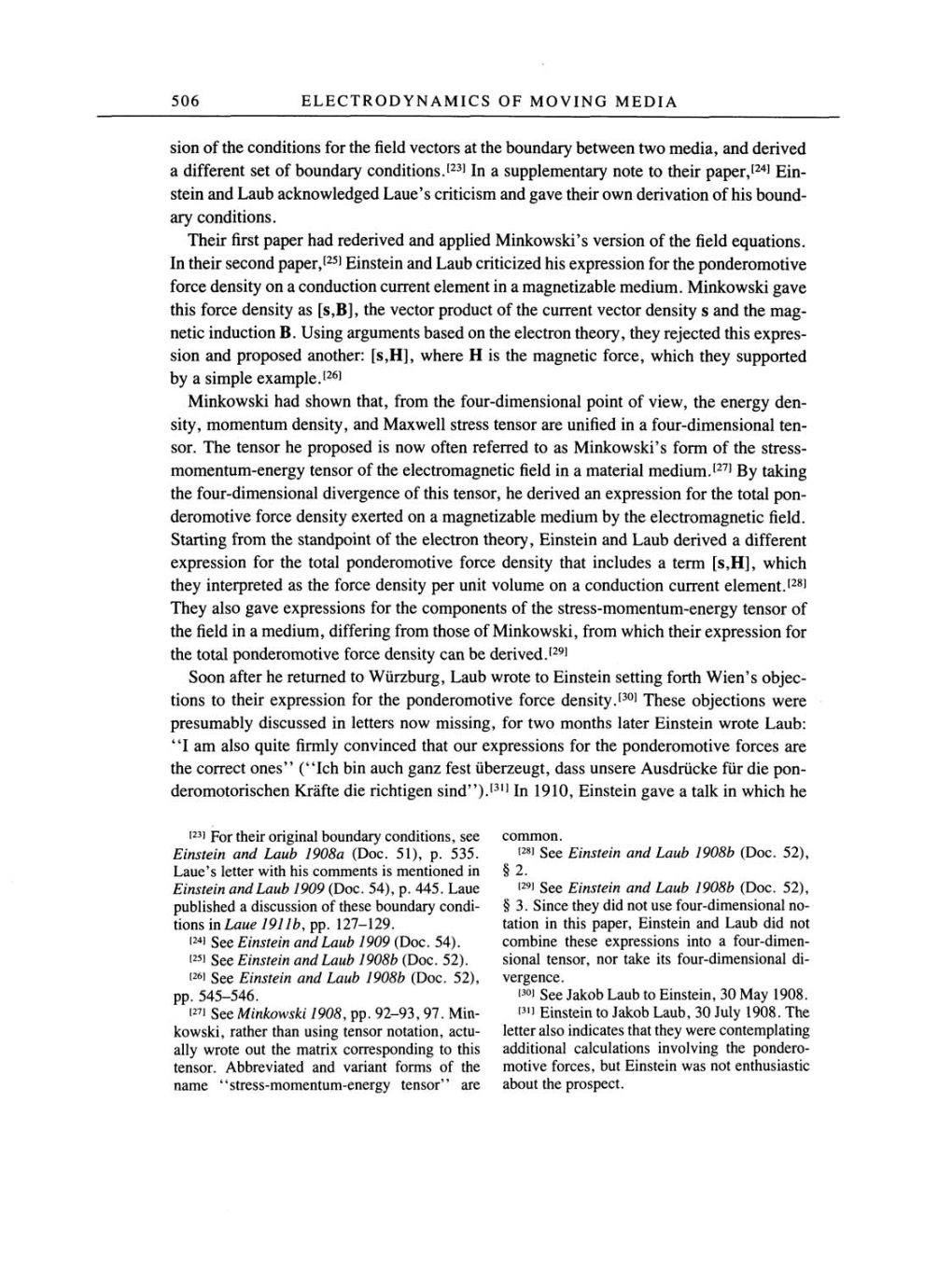506 ELECTRODYNAMICS OF MOVING MEDIA
sion
of
the
conditions
for
the field
vectors at
the
boundary
between two media, and
derived
a
different
set
of
boundary
conditions.[23] In
a supplementary
note to
their
paper,[24]
Ein-
stein and Laub
acknowledged
Laue's
criticism and
gave
their
own
derivation of
his
bound-
ary
conditions.
Their
first
paper
had rederived and
applied
Minkowski's
version
of
the
field
equations.
In
their
second
paper,[25]
Einstein and Laub criticized his
expression
for
the
ponderomotive
force
density on a
conduction current element
in
a
magnetizable
medium.
Minkowski
gave
this force
density
as
[s,B],
the
vector
product
of
the current vector
density s
and the
mag-
netic induction
B.
Using arguments
based
on
the electron
theory, they rejected
this
expres-
sion and
proposed
another:
[s,H],
where H
is
the
magnetic
force, which
they supported
by a simple
example.[26]
Minkowski had shown
that,
from
the four-dimensional
point
of
view,
the
energy
den-
sity,
momentum
density,
and
Maxwell stress tensor
are
unified in
a
four-dimensional
ten-
sor.
The
tensor he
proposed
is
now
often referred to
as
Minkowski's
form
of
the stress–
momentum-energy
tensor
of
the
electromagnetic
field in
a
material
medium.[27]
By taking
the four-dimensional
divergence
of
this
tensor,
he
derived
an expression
for the total
pon-
deromotive force
density
exerted
on a magnetizable
medium
by
the
electromagnetic
field.
Starting
from
the
standpoint
of
the electron
theory,
Einstein and Laub derived
a
different
expression
for the total
ponderomotive
force
density
that includes
a
term
[s,H],
which
they interpreted as
the force
density per
unit volume
on a
conduction current element.[28]
They
also
gave
expressions
for the
components
of
the
stress-momentum-energy
tensor
of
the field in
a medium,
differing
from those
of
Minkowski,
from which
their
expression
for
the total
ponderomotive
force
density can
be
derived.[29]
Soon after
he
returned
to
Würzburg,
Laub wrote to Einstein
setting
forth
Wien's
objec-
tions to their
expression
for
the
ponderomotive
force
density.[30]
These
objections were
presumably
discussed in letters
now
missing,
for
two
months later Einstein
wrote
Laub:
"I
am
also
quite
firmly
convinced that
our expressions
for the
ponderomotive
forces
are
the correct
ones"
("Ich
bin auch
ganz
fest
überzeugt,
dass
unsere
Ausdrücke
für
die
pon-
deromotorischen Kräfte die
richtigen
sind").[31]
In
1910,
Einstein
gave a
talk in which he
[23]
For
their
original
boundary conditions,
see
Einstein
and
Laub 1908a
(Doc. 51), p.
535.
Laue's
letter
with his comments is mentioned in
Einstein
and Laub 1909
(Doc. 54), p.
445. Laue
published
a
discussion
of
these
boundary
condi-
tions in
Laue
1911b, pp.
127-129.
[24]
See
Einstein and
Laub 1909
(Doc. 54).
[25]
See Einstein
and
Laub 1908b
(Doc. 52).
[26]
See Einstein
and
Laub 1908b
(Doc. 52),
pp.
545-546.
[27]
See Minkowski
1908,
pp.
92-93, 97. Min-
kowski,
rather than
using
tensor notation,
actu-
ally
wrote
out the matrix
corresponding
to this
tensor. Abbreviated
and variant forms
of
the
name
"stress-momentum-energy
tensor"
are
common.
[28]
See
Einstein and
Laub 1908b
(Doc. 52),
§2.
[29]
See Einstein
and
Laub 1908b
(Doc. 52),
§
3.
Since
they
did
not
use
four-dimensional
no-
tation in this
paper,
Einstein and Laub did
not
combine these
expressions
into
a
four-dimen-
sional
tensor,
nor
take its four-dimensional di-
vergence.
[30]
See Jakob
Laub to
Einstein,
30
May
1908.
[31]
Einstein to Jakob
Laub,
30
July
1908. The
letter also indicates that
they were contemplating
additional calculations
involving
the
pondero-
motive
forces,
but Einstein
was
not enthusiastic
about the
prospect.
